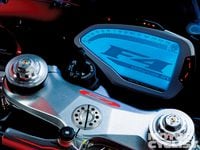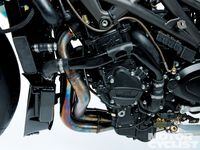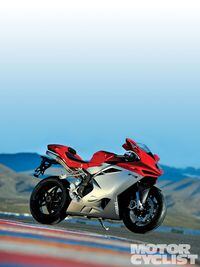The coffee at breakfast was hopelessly weak, but who needs caffeine on a morning like this? I'm enjoying my first ride on the redrawn MV Agusta F4, whose gloriously tortured exhaust howl is assaulting my eardrums as I snick through the gearbox.
On the straights, the F4 slices through the cold morning air with eye-watering velocity. In the twisty sections, it slows with force and corners with effortless precision as I chase the underseat tailpipes of the rider ahead.
Launching a sportbike on the road is unusual these days, but it's easy to understand why we've been let out on these swaying Spanish roads before this afternoon's track sessions at Almeria. MV's big four has always excelled on the track, winning numerous comparison tests and earning a reputation as a fearsomely quick and uncompromising track weapon. But it also works well on the road.
Like the revised Brutale models that the Italian marque released late last year, this "new" F4 is intended to add some refinement and rider-friendliness to the MV mix. Its engine has been reworked to respond less abruptly and rev smoother, and its chassis has been redesigned to track more compliantly. The F4 has had some rough edges polished out to leave a more rounded-but definitely not soft-character.
Visually, the opposite is true. Some of the soft curves of Massimo Tamburini's original masterpiece have been straightened by Adrian Morton, Tamburini's British apprentice who returned to MV from Benelli before the maestro's retirement a year ago. That fairing nose is slightly sharper, as are the tank and tailpiece. Square-section silencers replace the cylindrical organ pipes of the original model, and the fairing's angular slots give glimpses of the engine's red-painted cylinder head (or testa rossa, as Ferrari calls it). That 998cc, radial 16-valve motor contains numerous lighter and more compact parts, as well as one heavier one: Crankshaft mass has been increased for smoother, more controlled engine response.
There are plenty of chassis changes, too. The frame still combines steel tubes with aluminium plates at the swingarm pivot, but steering geometry is steeper and that swingarm has been extended by 20mm. Numerous small tweaks add up to a claimed 22-pound weight savings, with dry weight listed as 423 lbs. The wet figure will approach 450 lbs, but that's still pretty respectable for a bike whose basic design was drawn up in the mid-'90s.
The F4 fires up with a gravelly sound, and accelerates as quickly as its predecessor, but with a more refined feel. As the revs rise toward the 13,500-rpm limit, the F4 remains smooth-a welcome contrast from the old bike's buzzy nature. This F4 benefits from variable-length inlet trumpets, carried over from the limited-edition Tamburini model, which change length at 10,500 rpm to boost midrange response while allowing optimum high-rev performance. The big motor feels pretty flat below 5000 rpm, but by the time the tach needle hits 7000 the F4 is ready for business.
The bike's softer suspension felt plush yet the bike still tracked well, running true through everything from sweeping curves to hillside hairpins. The seat has been moved forward by 20mm, giving less of a stretch to the bars. Shorter riders should welcome that, though some might struggle with the seat height, which is nearly an inch higher than the F4 RR 312's. Being over 6-feet tall, I could get both feet on the ground with no trouble, but I struggled with the high footpegs. The old F4 had adjustable rearsets, but MV fitted the new bike with non-adjustable pegs that cramped my legs on the road and still felt awkwardly high on the track. Short riders can't do anything about the seat height, but at least tall owners have the option of buying the accessory adjustable footpegs, although they really should be standard fitment on a bike expected to have a $20,000+ price tag.
At Almeria, the MV navigated the sweeping curves and made short work of the long back straight, cornering with ease although not with the ultra-light feel of some of its rivals. The F4 incorporates a traction-control system similar to the Brutale's, but I didn't notice it kicking in.
The MV is certainly impressive on the racetrack, though whether it would lap this or any other circuit quicker than its predecessor is open to conjecture. Pure performance is unlikely to have been significantly improved by the changes, but as an all-around superbike for road and occasional track-day use, it's a much better machine. And it still has the unique MV Agusta blend of beauty, tradition and soul that makes for a memorable riding experience.
tech
SPEC
Evolution
The "World's Most Beautiful Motorcycle" gets a host of aesthetic and mechanical upgrades to help it retain its title.
Rivals
Aprilia RSV4 Factory, BMW S1000RR, Ducati 1198S, KTM RC8R.
Contact
MV Agusta USA
2300 Maryland Rd.
Willow Grove, PA 19090
215.830.3300
www.mvagustausa.com
Verdict 4.5 stars out of 5
The same fabulous F4, but with a fiercer look and a gentler ride.















/cloudfront-us-east-1.images.arcpublishing.com/octane/VZZXJQ6U3FESFPZCBVXKFSUG4A.jpg)
/cloudfront-us-east-1.images.arcpublishing.com/octane/QCZEPHQAMRHZPLHTDJBIJVWL3M.jpg)
/cloudfront-us-east-1.images.arcpublishing.com/octane/HXOUJXQWA5HBHGRO3EMJIGFMVI.jpg)

/cloudfront-us-east-1.images.arcpublishing.com/octane/3TIWWRV4JBBOLDVGRYECVVTA7Y.jpg)
/cloudfront-us-east-1.images.arcpublishing.com/octane/KIX5O23D5NAIBGFXBN3327DKZU.jpg)
/cloudfront-us-east-1.images.arcpublishing.com/octane/7GJYDUIPXRGMTMQKN6ONYOLBOU.jpg)
/cloudfront-us-east-1.images.arcpublishing.com/octane/MUQLOVLL2ZDGFH25ILABNBXKTI.jpg)
/cloudfront-us-east-1.images.arcpublishing.com/octane/TNOU5DNE2BC57MFPMGN2EIDXAM.jpg)
/cloudfront-us-east-1.images.arcpublishing.com/octane/GTCXACQGJ5HAPDTGWUQKDEH44E.jpg)
/cloudfront-us-east-1.images.arcpublishing.com/octane/S35YGSEMEZB4BLTDJTSZPF4GLA.jpg)
/cloudfront-us-east-1.images.arcpublishing.com/octane/5UOT6HPX2JFMRJAX6EH45AR4MQ.jpg)
/cloudfront-us-east-1.images.arcpublishing.com/octane/OKWOJWAKP5EP3OACCRRWPCIX2Q.jpg)
/cloudfront-us-east-1.images.arcpublishing.com/octane/2WF3SCE3NFBQXLDNJM7KMXA45E.jpg)
/cloudfront-us-east-1.images.arcpublishing.com/octane/G4MG6OUCJNBSHIS2MVVOTPX65E.jpg)
/cloudfront-us-east-1.images.arcpublishing.com/octane/IIGGWFOTOJGB7DB6DGBXCCMTDY.jpg)
/cloudfront-us-east-1.images.arcpublishing.com/octane/QSTCM6AVEZA5JJBUXNIQ3DSOF4.jpg)
/cloudfront-us-east-1.images.arcpublishing.com/octane/U4I7G625B5DMLF2DVIJDFZVV6M.jpg)
/cloudfront-us-east-1.images.arcpublishing.com/octane/B6XD6LS6IVCQPIU6HXDJSM3FHY.jpg)
/cloudfront-us-east-1.images.arcpublishing.com/octane/ICL63FEDDRDTTMINYICCEYGMDA.jpg)
/cloudfront-us-east-1.images.arcpublishing.com/octane/FCGZHQXRBZFLBAPC5SDIQLVF4I.jpg)
/cloudfront-us-east-1.images.arcpublishing.com/octane/WNOB6LDOIFFHJKPSVIWDYUGOPM.jpg)

/cloudfront-us-east-1.images.arcpublishing.com/octane/X33NU3E525ECRHXLNUJN2FTRKI.jpg)